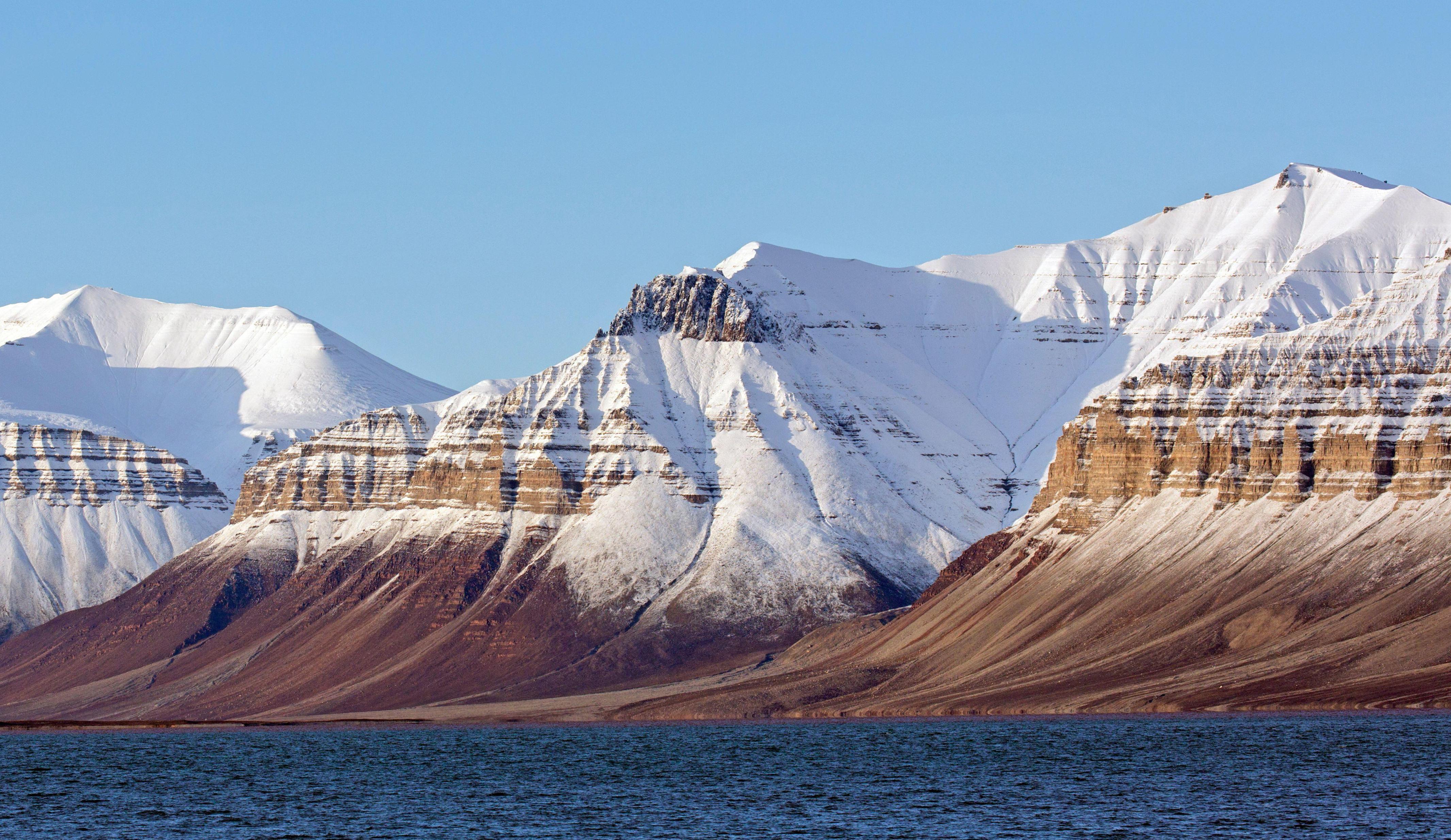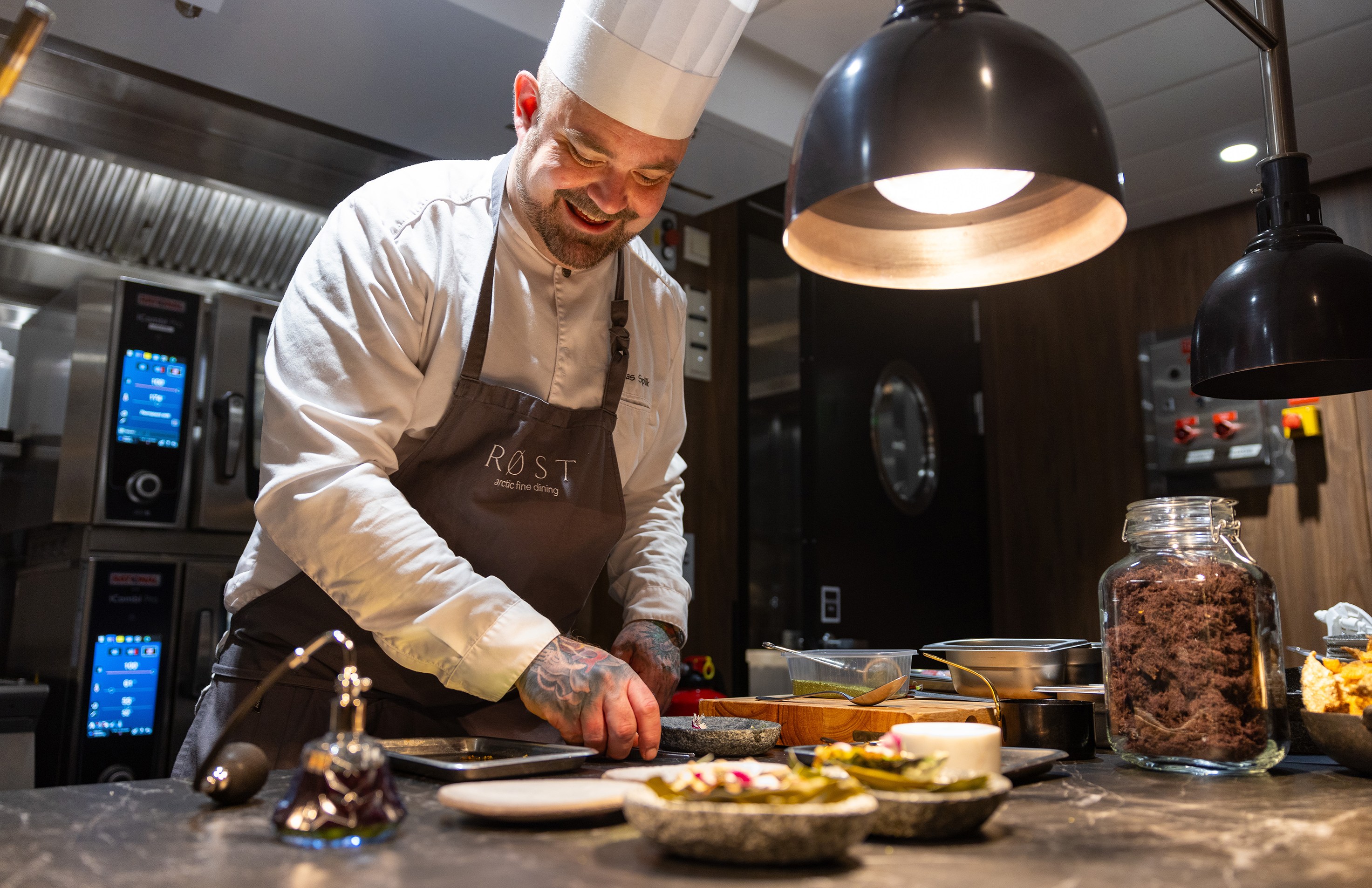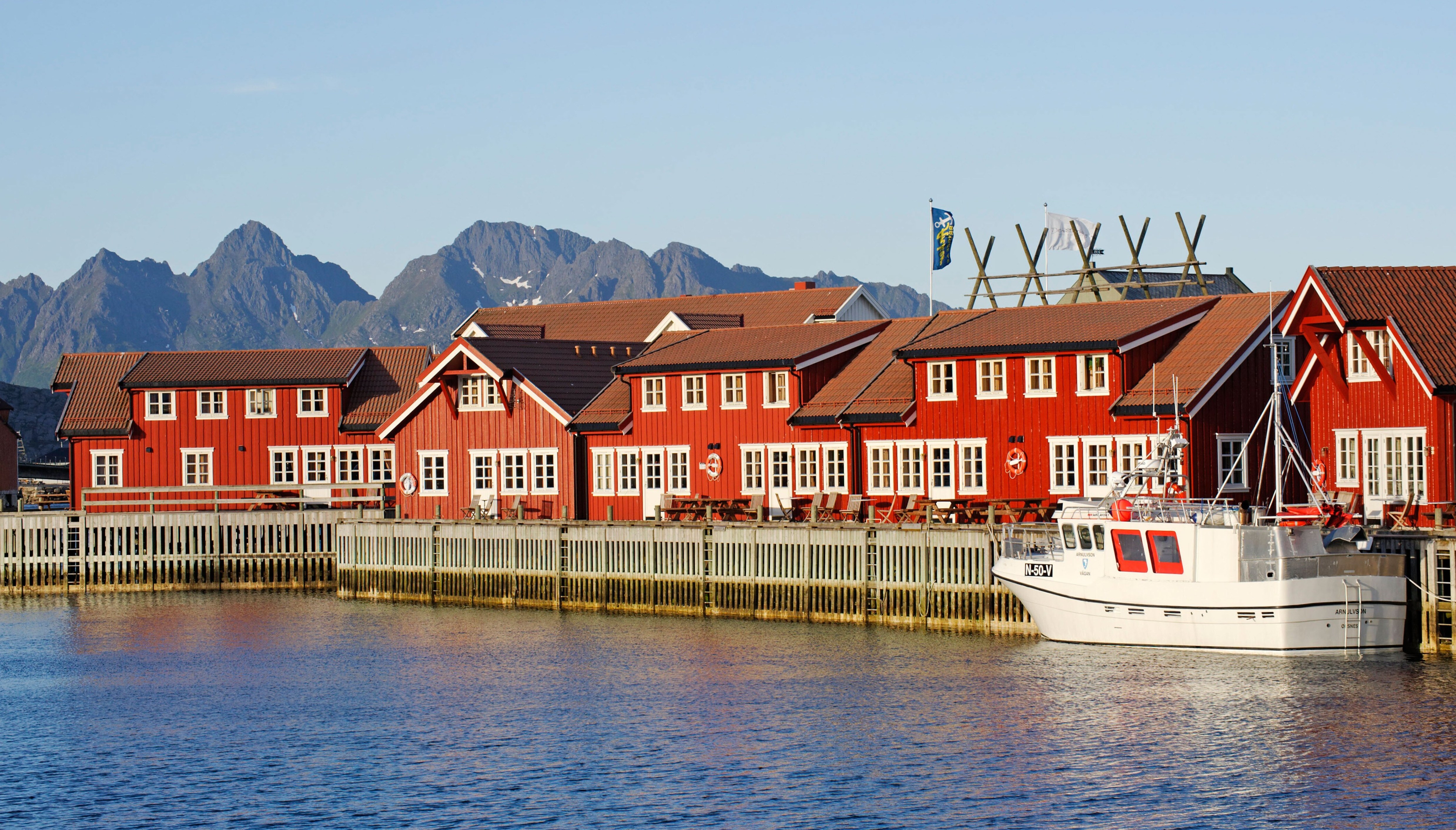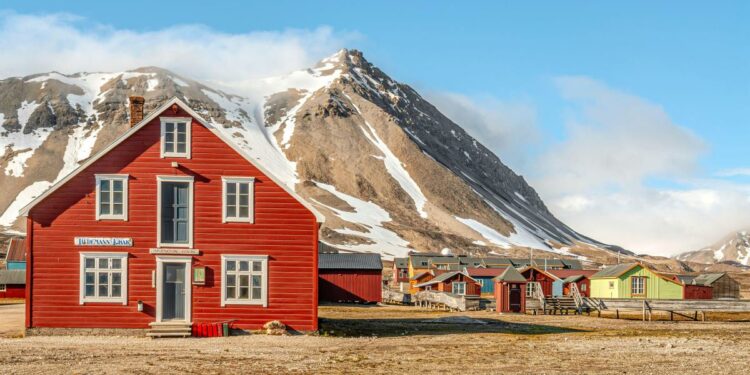After a few days, first in Svalbard then aboard MS Trollfjord, I have been impressed with Hurtigruten’s commitment to local produce and towards zero food waste, but Trevland really brings it all home to me with his enthusiasm for this simple feelgood ingredient. It’s one that every Norwegian associates with kos — a sense of cosy togetherness over good food and drink.
I boarded MS Trollfjord in the port of Longyearbyen. Standing on the archipelago, the town is the world’s northernmost settlement of more than 1,000 people. We are deep inside the Arctic Circle and this geographical extreme is reflected everywhere; signs for the “world’s most northern car hire company” and the “world’s northernmost museum” are all around.
Longyearbyen is a remote, romantic place with a frontier feel, ringed in by cold, dark seas and high, snow-dusted mountains. I am to discover the real beauty of Svalbard in the coming days, but the problems of living in this remote region are immediately apparent. The permafrost goes 100m below ground (making Longyearbyen the perfect home for the Global Seed Vault), with only the first metre thawing in summer. Nothing can be buried and all around the dock area is waste waiting to be shipped away. I’m here in August, when there are 24 hours of daylight, but only a few flowers have poked their way out of the thin soil. Glaciers cover 60 per cent of Svalbard and the fragility of this polar environment is easy to see. Recycling and sustainability are not just fashionable buzzwords here, they’re a way of life.
The MS Trollfjord follows the beautiful Svalbard Line in Norway
TOMMY SIMONSEN
Outside Longyearbyen is the “world’s northernmost gourmet restaurant”. Now owned by Hurtigruten, Huset (or “House” in English) radiates kos in a series of wood-panelled rooms. At a communal table in the wine cellar I eat a 16-course menu (£186pp) featuring ingredients such as deer throat and dried seal; each dish is presented on quirky table settings, including antlers and fossils from the nearby hills.
Sixteen courses sounds excessive, but each is tiny yet exquisite. Equally imaginative pairings include fine wines from a collection of 15,000 bottles, saké and aquavit. Standouts include a crab soup with crab-shell caramel, scallop served three ways and rock ptarmigan. I start taking notes while eating the deer throat (“Briny. Long aftertaste of mild spice”), but I soon run out of words, never mind superlatives.
• 14 of the best northern lights cruises for 2024 and 2025
The chef Alberto Lozano and his team forage in the hills for fungi, berries and wild herbs, while the meat is sourced from hunters he knows. He emphasises his commitment to use every part of every ingredient. I see this in a dish of turbot in which the skin is crisped as a topping and the bones simmered for days to make a base for the sauce. Huset may not have a Michelin star, but it seems only a matter of time.
After a night at the luxurious Funken Lodge — “the northernmost boutique hotel” is all low-slung lights, mid-century furniture and cosy throws (B&B doubles from £187; hurtigrutensvalbard.com) — I join a Wildlife and Glacier Cruise day trip on MS Bard, Hurtigruten Svalbard’s hybrid-electric catamaran. Its quiet engine is designed to avoid disturbing wildlife and I soon see a minke whale blowing off the starboard side. Puffins and guillemots glide alongside as we sail up Billefjorden, passing the abandoned Soviet mining town of Pyramiden (£194pp).

Look out for puffins as you go past the mountains at Billefjorden
ALAMY
At the Nordenskioldbreen glacier the fjord ends and we slowly turn. The blue ice towers over us and chunks break the calm waters. An icy wind blows off the glacier and I snuggle into my coat, in awe of the beauty of it all.
That cruise is merely a taste of the sights I see once aboard MS Trollfjord. Fjords, glaciers and seabirds endlessly pass my suite’s panoramic bay window. The dark Arctic Sea is a constantly changing counterpoint to busy mornings when we call at ports to take on and offload cargo. There are glimpses of farms with red barns and voyeuristic looks into isolated homes on clifftops.
On board I learn more about Hurtigruten’s boast to be the most sustainable cruise company. For every day I choose not to have my cabin cleaned 40p is donated to the Hurtigruten Foundation, which supports projects such as remote beach clean-ups on Svalbard; plus the company has pledged to have an emission-free ship on its classic Coastal Express route by 2030.
• The 30 best cruise lines for every kind of traveller
Our first stop is Ny-Alesund, a tiny settlement on Svalbard that is home to a few hundred scientific researchers from multiple nations. We are told that if we see a polar bear we are to go into any of the houses for refuge; they are all left unlocked for this purpose.
Signs on each road out of town warn that you should not proceed without a firearm. For the short distance to a rusty airship mooring pylon we gather in a group with an armed guard named Ruben. He takes his job seriously: when I ask for a photograph he agrees but tells me not to block his line of sight. “I have only seconds to react if a polar bear comes,” he says, gripping his rifle.
The pylon was used by Roald Amundsen for the first flight over the North Pole in 1926. A larger-than-life bust of the Norwegian explorer stands near the post office in town. Cast in bronze, he is depicted with a generous nose that looks as though it could break its way through an icefield without a ship.
We don’t see a polar bear in Ny-Alesund, but MS Trollfjord has only just left the port when one appears on land. The announcement of a sighting brings a crowd to the rails; among the dozens of passengers are members of the crew looking just as excited. It can barely be seen with the naked eye, but my suite comes with a good pair of binoculars. I learn later from the ship’s captain that we are a kilometre away from the bear and regulations dictate that we can’t go any closer. Watching it snack idly on a seal carcass I am thrilled to be in a place where such magnificent animals roam free.

Rost is MS Trollfjord’s fine-dining spot where traditional Norwegian ingredients are given a modern spin
ESPEN MILLS
Andre Gasemyr, the chef for the on board fine-dining restaurant Rost, is a red-bearded giant of a man who looks as though he could easily wrestle a bear. Gentle and shy, he also seems much happier being in the kitchen than talking about it. “It’s nice to work along the coast because we have all the local produce at every port,” he says. “But we have to be flexible because there can be a lot of last-minute changes with suppliers. For example, some specialised fresh seafood can be hard to get, as it’s very seasonal.”
It’s mesmerising to watch his large hands delicately plate tiny creations. At dinner every evening I never know what to expect, but it’s always a delicious surprise. I am not amazed to learn that Gasemyr has worked in several Michelin-recognised restaurants, including one with three stars.
• 10 of the best cruise lines for first-timers
“Norwegian food is simple,” he says. “In the old days you either boiled, cured or fermented it. We use the old ways but serve it in a new-age way. I really like working with game, as a hunter and fisherman myself. I also use a lot of seaweed.”
At Stokmarknes, on Hadseloya Island in Nordland, the Hurtigruten Museum is a few steps from the dock. It is built around MS Finnmarken, which was launched by Hurtigruten in 1956. Our guide, Adelaide, tells us how a newborn whose mother had died was ferried on one of the old Coastal Express ships to her grandparents’ home, with the company arranging a wet nurse to feed her in each port; now elderly, she has been to visit the museum. The story brings home how deep the company’s links to the community go.

The harbour in Svolvaer
ALAMY
My last adventure is in Svolvaer, in the Lofoten archipelago. Taking a Rib in search of sea eagles we speed towards a group of small islands and, within minutes, a dozen eagles swoop down on bait thrown by our skipper. Grabbing whole fish from the water in their talons, the eagles beat their way back to a nearby rock to consume it (£134pp).
They tear at the flesh with their beaks, until every part is consumed. Lozano would very much approve.
This article contains affiliate links, which can earn us revenue
Kieran Meeke was a guest of Hurtigruten, which has seven nights’ all-inclusive on its Svalbard Line — South itinerary (Svalbard to Bergen) from £2,267pp, with departures from June 2025 (hurtigruten.com). Fly to Longyearbyen
Become a subscriber and, along with unlimited digital access to The Times and The Sunday Times, you can enjoy a collection of travel offers and competitions curated by our trusted travel partners, especially for Times+ members
Sign up for our Times Travel newsletter and follow us on Instagram and X
Source link : https://www.thetimes.com/travel/destinations/europe-travel/norway/svalbard/article/cruise-hurtigruten-funken-lodge-ckq76zlpq
Author :
Publish date : 2024-10-28 00:01:00
Copyright for syndicated content belongs to the linked Source.


